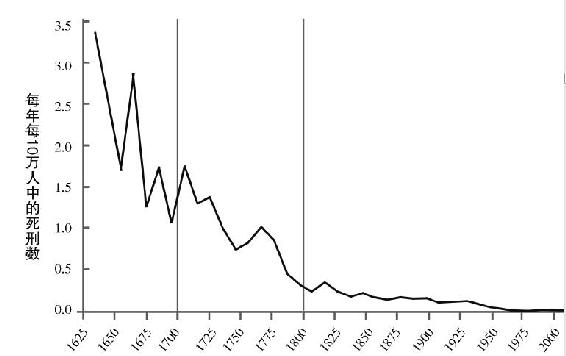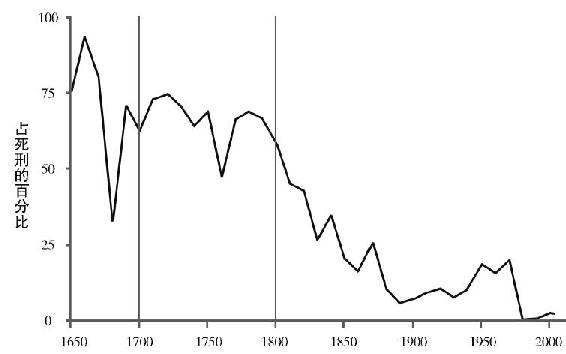(4) 死刑 Capital Punishment | 人性中的善良天使
1 / 7
When England introduced drop hanging in 1783 and France introduced the guillotine in 1792, it was a moral advance, because an execution that instantly renders the victim unconscious is more humane than one that is designed to prolong his suffering. But execution is still a form of extreme violence, especially when it is applied as frivolously as most states did for most of human history. In biblical, medieval, and early modern times, scores of trivial affronts and infractions were punishable by death, including sodomy, gossiping, stealing cabbages, picking up sticks on the Sabbath, talking back to parents, and criticizing the royal garden. During the last years of the reign of Henry VIII, there were more than ten executions in London every week. By 1822 England had 222 capital offenses on the books, including poaching, counterfeiting, robbing a rabbit warren, and cutting down a tree. And with an average trial length at the time of eight and a half minutes, it is certain that many of the people sent to the gallows were innocent. Rummel estimates that between the time of Jesus and the 20th century, 19 million people were executed for trivial offenses.
查看中文翻译
(4) 死刑 Capital Punishment | 人性中的善良天使
2 / 7
But as the 18th century came to a close, capital punishment itself was on death row. Public hangings, which had long been rowdy carnivals, were abolished in England in 1783. The display of corpses on gibbets was abolished in 1834, and by 1861 England's 222 capital offenses had been reduced to 4. During the 19th century many European countries stopped executing people for any crime but murder and high treason, and eventually almost every Western nation abolished capital punishment outright. To get ahead in the story, figure 4-3 shows that of the fifty-three extant European countries today, all but Russia and Belarus have abolished the death penalty for ordinary crimes. (A handful keep it on the books for high treason and grave military offenses.) The abolition of capital punishment snowballed after World War II, but the practice had fallen out of favor well before that time. The Netherlands, for example, officially abolished capital punishment in 1982, but hadn't actually executed anyone since 1860. On average fifty years elapsed between the last execution in a country and the year that it formally abolished capital punishment.
查看中文翻译
(4) 死刑 Capital Punishment | 人性中的善良天使
3 / 7
Today capital punishment is widely seen as a human rights violation. In 2007 the UN General Assembly voted 105-54 (with 29 abstentions) to declare a nonbinding moratorium on the death penalty, a measure that had failed in 1994 and 1999. One of the countries that opposed the resolution was the United States. As with most forms of violence, the United States is an outlier among Western democracies (or perhaps I should say "are outliers," since seventeen states, mostly in the North, have abolished the death penalty as well -- four of them within the past two years -- and an eighteenth has not carried out an execution in forty-five years). But even the American death penalty, for all its notoriety, is more symbolic than real. Figure 4-4 shows that the rate of executions in the United States as a proportion of its population has plummeted since colonial times, and that the steepest drop was in the 17th and 18th centuries, when so many other forms of institutional violence were being scaled back in the West.
查看中文翻译

(4) 死刑 Capital Punishment | 人性中的善良天使
4 / 7
Sources: French Ministry of Foreign Affairs, 2007; Capital Punishment U. K., 2004; Amnesty International, 2010.
查看中文翻译
FIGURE 4-3: Time line for the abolition of capital punishment in Europe
查看中文翻译

The barely visible swelling in the last two decades reflects the tough-on-crime policies that were a reaction to the homicide boom of the 1960s, 1970s, and 1980s. But in present-day America a "death sentence" is a bit of a fiction, because mandatory legal reviews delay most executions indefinitely, and only a few tenths of a percentage point of the nation's murderers are ever put to death. And the most recent trend points downward: the peak year for executions was 1999, and since then the number of executions per year has been almost halved.
查看中文翻译
FIGURE 4-4: Execution rate in the United States, 1640-2010
查看中文翻译
Sources: Payne, 2004, p. 130, based on data from Espy & Smykla, 2002. The figures for the decades ending in 2000 and 2010 are from Death Penalty Information Center, 2010b.
查看中文翻译
(4) 死刑 Capital Punishment | 人性中的善良天使
5 / 7
At the same time that the rate of capital punishment went down, so did the number of capital crimes. In earlier centuries people could be executed for theft, sodomy, buggery, bestiality, adultery, witchcraft, arson, concealing birth, burglary, slave revolt, counterfeiting, and horse theft. Figure 4-5 shows the proportion of American executions since colonial times that were for crimes other than homicide. In recent decades the only crime other than murder that has led to an execution is "conspiracy to commit murder." In 2007 the U. S. Supreme Court ruled that the death penalty may not be applied to any crime against an individual "where the victim's life was not taken" (though the death penalty is still available for a few "crimes against the state" such as espionage, treason, and terrorism).
查看中文翻译
The means of execution has changed as well. Not only has the country long abandoned torture-executions such as burning at the stake, but it has experimented with a succession of "humane" methods, the problem being that the more effectively a method guarantees instant death (say, a few bullets to the brain), the more gruesome it will appear to onlookers, who don't want to be reminded that violence has been applied to kill a living body. Hence the physicality of ropes and bullets gave way to the invisible agents of gas and electricity, which have been replaced by the quasi-medical procedure of lethal injection under general anesthesia -- and even that method has been criticized for being too stressful to the dying prisoner. As Payne has noted,
查看中文翻译
(4) 死刑 Capital Punishment | 人性中的善良天使
6 / 7

In reform after reform lawmakers have moderated the death penalty so that it is now but a vestige of its former self. It is not terrifying, it is not swift, and in its present restricted use, it is not certain (only about one murder in two hundred leads to an execution). What does it mean, then, to say that the United States "has" the death penalty? If the United States had the death penalty in robust, traditional form, we would be executing approximately 10,000 prisoners a year, including scores of perfectly innocent people. The victims would be killed in torture-deaths, and these events would be shown on nationwide television to be viewed by all citizens, including children (at 27 executions a day, this would leave little time for any other television fare). That defenders of capital punishment would be appalled by this prospect shows that even they have felt the leavening effects of the increasing respect for human life.
查看中文翻译
FIGURE 4-5: Executions for crimes other than homicide in the United States, 1650-2002
查看中文翻译
(4) 死刑 Capital Punishment | 人性中的善良天使
7 / 7
Sources: Espy & Smykla, 2002; Death Penalty Information Center, 2010a.
查看中文翻译
One can imagine that in the 18th century the idea of abolishing capital punishment would have seemed reckless. Undeterred by the fear of a grisly execution, one might have thought, people would not hesitate to murder for profit or revenge. Yet today we know that abolition, far from reversing the centuries-long decline of homicide, proceeded in tandem with it, and that the countries of modern Western Europe, none of which execute people, have the lowest homicide rates in the world. It is one of many cases in which institutionalized violence was once seen as indispensable to the functioning of a society, yet once it was abolished, the society managed to get along perfectly well without it.
查看中文翻译